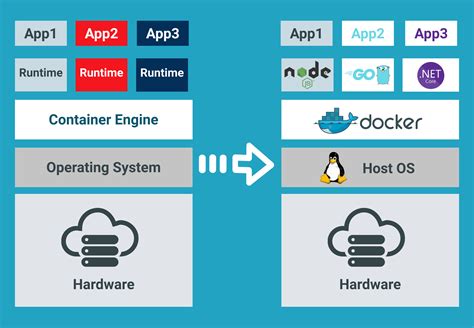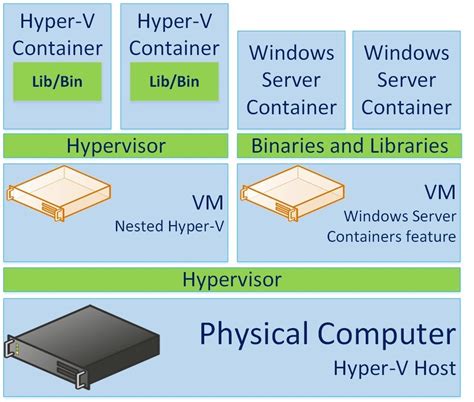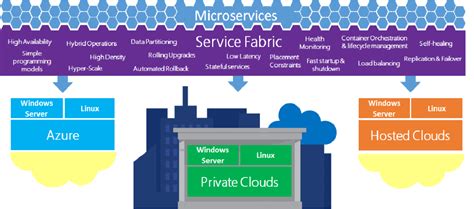Are you ready to delve into the world of containerization and orchestration on the Windows platform? In this article, we will explore the exciting possibilities that Docker and Service Fabric offer for managing and deploying applications on Windows Server. Whether you are a developer, a system administrator, or an IT professional, this guide will provide you with the essential knowledge to get started with these powerful tools.
Containerization has revolutionized the way applications are developed, deployed, and run. By encapsulating applications and their dependencies into lightweight and isolated containers, developers can build, ship, and run applications consistently across any environment. Docker, a popular containerization platform, has gained immense popularity in the world of software development, and now, it has extended its support to Windows Server as well.
Service Fabric, on the other hand, takes containerization to the next level by offering a distributed systems platform for building and managing scalable and reliable microservices. With its advanced capabilities for auto-scaling, health monitoring, and rolling upgrades, Service Fabric simplifies the development and management of complex, cloud-native applications. By combining Docker and Service Fabric, you can enjoy the benefits of both containerization and orchestration in your Windows environment.
In this guide, we will walk you through the step-by-step process of setting up Docker and Service Fabric on Windows Server. We will cover everything from the installation of the necessary software components to the deployment and management of containerized applications. By the end of this guide, you will have a solid foundation in deploying and managing containerized applications using Docker and Service Fabric on Windows Server.
Introduction to Docker for Windows

In this section, we will explore the concept of Docker Windows and its significance in the context of managing and deploying applications on Windows-based systems. By understanding the core principles of Docker Windows, you will gain insights into its capabilities and how it simplifies the process of running containerized applications on Windows Server.
At its core, Docker Windows is a platform that enables efficient and isolated execution of applications within lightweight, portable containers. These containers offer a consistent and reproducible environment for running software, regardless of the underlying infrastructure. With Docker Windows, developers and system administrators can package their applications and their dependencies into self-contained units, also known as Docker images.
One of the key advantages of Docker Windows is its ability to minimize conflicts and compatibility issues between different environments. It achieves this through the use of containerization technology, which encapsulates applications into discrete units that operate independent of other components in the system. This isolation allows for greater flexibility and agility in deploying and scaling applications on Windows Server.
Furthermore, Docker Windows provides a consistent development and deployment environment, empowering teams to work collaboratively and iteratively. Developers can easily share their Docker images, ensuring that everyone is using the same version of an application throughout the development lifecycle. With Docker Windows, application deployment becomes a streamlined process, reducing the time and effort required to move an application from development to production.
Overall, Docker Windows is a powerful tool for managing and deploying applications on Windows Server. Its containerization capabilities, combined with its flexibility and ease of use, make it an essential component for modern software development and deployment workflows.
Benefits of Docker for Windows
In this section, we will explore the numerous advantages and benefits of utilizing Docker for Windows in your development and deployment workflows. Docker provides a lightweight and efficient containerization platform that allows you to easily package, distribute, and deploy your applications across different environments.
1. Isolation and Portability: Docker for Windows ensures the isolation of your applications, providing a consistent and reliable environment regardless of the underlying host OS. It allows you to package all the necessary dependencies and configurations within a container, making it portable and easily movable across various environments, from development to production. |
2. Efficient Resource Utilization: With Docker, you can optimize the utilization of system resources by running multiple containers on a single host machine. It enables you to isolate and allocate specific resources to each container, ensuring efficient utilization and avoiding resource conflicts. |
3. Scalability and Elasticity: Docker makes it easy to scale your application by providing the ability to create multiple instances of containers based on demand. This allows your application to handle increased traffic or workloads without impacting its performance. You can easily scale up or down by adding or removing containers as required. |
4. Rapid Deployment and Rollbacks: Docker simplifies the deployment process by providing a streamlined and automated approach. It allows you to easily deploy your application as a container, reducing the time and effort required for the setup. Additionally, Docker enables fast rollbacks in case of any issues, as you can quickly switch to a previous version of the container. |
5. Collaboration and Version Control: Docker enables efficient collaboration by allowing developers to share and deploy containers easily. It also facilitates version control for your application, as you can create and manage different versions of containers, ensuring consistency and reproducibility of your builds. |
Introduction to Docker for Windows

The world of containerization has revolutionized the way in which software applications are developed, deployed, and managed. Docker for Windows brings the power of containerization to the Windows platform, allowing developers to create lightweight and portable application environments. In this section, we will explore the fundamental concepts of Docker for Windows and how it can benefit your development workflow.
1. Containers: Unlocking Application Portability
Containers provide a way to package and isolate applications, along with their dependencies, into a self-contained unit that can be run consistently across different environments. By encapsulating the application and its environment, containers offer portability, enabling developers to easily move applications from one machine to another, regardless of the underlying operating system.
2. Image-based Application Delivery
In the world of Docker, applications are packaged and distributed as immutable images. An image includes everything needed to run an application, including the code, runtime, libraries, and system tools. With Docker for Windows, you can leverage a vast ecosystem of pre-built images, readily available on Docker Hub, or build your own custom images to fit your specific requirements.
3. Efficient Resource Utilization
Docker's lightweight nature allows for efficient utilization of system resources. Containers share the host operating system's kernel, which means multiple containers can run simultaneously on a single server without the overhead of virtual machines. This enables efficient scaling, better utilization of hardware, and faster deployment times.
4. Streamlined Development Workflow
Docker for Windows provides a consistent environment for developers across different stages of the application lifecycle. With the ability to package and share development environments as Docker images, developers can eliminate the "it works on my machine" problem and ensure that their applications run consistently in any environment.
5. Integration with Existing Infrastructure
Docker for Windows seamlessly integrates with existing infrastructure and tooling. It supports container orchestration platforms, such as Kubernetes and Docker Swarm, enabling the deployment and management of containerized applications at scale. Additionally, Docker for Windows integrates with existing CI/CD pipelines, making it easy to incorporate containerized applications into your existing development workflow.
Installing Docker on Windows Server
In this section, we will explore the process of installing Docker on a Windows Server environment. By following these steps, you will be able to leverage the power of Docker to deploy and manage containers on your Windows Server machine.
Getting started with Docker on Windows Server begins with the installation process. The installation process involves downloading and configuring Docker, enabling you to run containers and containerized applications seamlessly.
To get started, you need to identify the latest version of Docker suitable for your Windows Server environment. Visit the official Docker website to find the compatible version. Once you have identified the version, proceed to download the Docker installation package.
After downloading the installation package, begin the installation process by running the executable file. Follow the on-screen instructions to install Docker on your Windows Server machine. During the installation, you may be required to choose options such as installing additional components and configuring network settings.
Once the installation is complete, Docker will be up and running on your Windows Server. You can verify the installation by opening a command prompt and executing the Docker command-line interface.
With Docker successfully installed on your Windows Server machine, you are now ready to explore its capabilities and start leveraging Docker to simplify your containerization and application deployment processes.
Exploring the World of Containers on Your Windows-enabled Server

Discover the excitement of delving into the containerized world on your Windows-enabled server. In this section, we will guide you through the process of running your very first Docker container, unlocking the power of containerization to enhance efficiency and scalability.
Service Fabric Deployment on Windows Server
Deploying Service Fabric on Windows Server is a crucial step in harnessing the power of distributed systems. In this section, we will explore the process of setting up and configuring Service Fabric on a Windows Server environment.
Before delving into the details, it is important to understand the underlying concepts and benefits associated with deploying Service Fabric on Windows Server. By leveraging the capabilities of Windows Server, organizations can achieve efficient resource utilization, improved scalability, and enhanced fault tolerance.
A key aspect of deploying Service Fabric on Windows Server is the installation and configuration process. This involves ensuring the compatibility of the Windows Server version with the Service Fabric platform, selecting appropriate hardware specifications, setting up networking configurations, and securing the deployment environment.
Once the initial setup is complete, the next step is to create a Service Fabric cluster on the Windows Server environment. This involves defining the cluster configuration, including the number of nodes, node types, naming conventions, and placement policies. The cluster setup also requires the installation and configuration of necessary dependencies, such as a reliable messaging store and a reliable state store.
After the cluster is successfully provisioned, it is essential to monitor and manage the Service Fabric deployment. This includes monitoring the health and performance of individual nodes, distributing load across the cluster, and handling failures and recoveries. Proper management of the Service Fabric deployment ensures optimal utilization of resources and smooth operation of distributed applications.
| Key Steps in Service Fabric Deployment on Windows Server |
|---|
| 1. Verify Windows Server compatibility |
| 2. Plan hardware specifications |
| 3. Configure networking settings |
| 4. Secure the deployment environment |
| 5. Create a Service Fabric cluster |
| 6. Define cluster configuration |
| 7. Install and configure necessary dependencies |
| 8. Monitor and manage the deployment |
Introduction to Service Fabric

In this section, we will explore the fundamental concepts and features of Service Fabric, a powerful framework for building and managing distributed systems on Windows Server. Service Fabric represents a cutting-edge solution for creating scalable, reliable, and maintainable applications.
Service Fabric provides a comprehensive set of tools and features that enable developers to easily build and deploy microservices-based applications. It offers a highly flexible and efficient runtime environment, allowing you to run your applications on clusters of machines, easily scaling them up or down based on demand.
With Service Fabric, you can take advantage of the benefits of a distributed architecture while abstracting away the complexities of managing individual services. It provides built-in support for automatic failover, service discovery, and load balancing, ensuring high availability and fault tolerance for your applications.
Furthermore, Service Fabric enables stateful services, allowing you to persist and manage the state of your applications across failures and restarts. This capability is particularly useful for building data-intensive applications or systems that require strong consistency guarantees.
Service Fabric also offers robust monitoring and diagnostics capabilities, allowing you to gain insights into the health and performance of your applications. You can monitor various metrics, trace logs, and automate monitoring tasks, ensuring seamless operation and troubleshooting.
In summary, Service Fabric empowers developers with a rich set of features and tools to build scalable, reliable, and manageable distributed applications. By abstracting away the complexities of distributed computing, Service Fabric enables you to focus on building business logic and delivering value to your users.
Deploying applications using Service Fabric on Windows Server
The process of deploying applications with Service Fabric on Windows Server is a vital step in the development and deployment of modern software solutions. This section focuses on the intricate process of deploying applications and provides a comprehensive guide to ensure smooth and efficient deployment.
Understanding the deployment workflow: Deploying applications with Service Fabric involves a series of steps that need to be followed meticulously. It starts with preparing the application package, configuring the deployment parameters, and selecting appropriate deployment options.
Configuring deployment parameters: Before initiating the deployment process, it is crucial to configure various deployment parameters to ensure that the application runs efficiently. These parameters include defining resource requirements, network configuration, security settings, and cluster-specific configurations.
Selecting deployment options: Service Fabric offers different deployment options based on the specific requirements of the application and the environment. It is important to choose the appropriate deployment option, such as a standalone cluster or a cluster hosted in Azure, to ensure optimal performance and scalability.
Performing the deployment: Once all the necessary configurations and settings are in place, the deployment process can be initiated. This involves deploying the application package to the target cluster, validating the deployment, and monitoring the progress to ensure successful deployment.
Scaling and managing deployed applications: Service Fabric provides powerful scaling and management capabilities that enable efficient management of deployed applications. This section explores the various techniques and best practices for scaling applications and effectively managing their lifecycle.
Monitoring and troubleshooting: Monitoring the deployed applications is crucial for identifying potential issues and ensuring their smooth operation. This section covers various monitoring techniques and tools available in Service Fabric to proactively detect and resolve any performance or functionality-related issues.
Conclusion: Deploying applications with Service Fabric on Windows Server is a critical aspect of the software development lifecycle. Understanding the deployment workflow, configuring deployment parameters, selecting appropriate deployment options, and effectively managing and monitoring deployed applications are essential for successful and efficient deployment on Windows Server.
Learn Docker in 7 Easy Steps - Full Beginner's Tutorial
Learn Docker in 7 Easy Steps - Full Beginner's Tutorial by Fireship 1,798,727 views 3 years ago 11 minutes, 2 seconds
Using NCache in Microsoft Azure Service Fabric with Docker
Using NCache in Microsoft Azure Service Fabric with Docker by NCache 303 views 2 years ago 23 minutes
FAQ
What is Docker Windows?
Docker Windows is a platform that allows you to run and manage containerized applications on Windows systems. It provides a lightweight and efficient way of packaging, distributing, and running applications in isolated environments called containers.
How can I get started with Docker Windows on Windows Server?
To get started with Docker Windows on Windows Server, you need to have a Windows Server 2016 or later version running on your machine. Then, you can follow the installation guide provided by Docker to set up Docker on your Windows Server. Once Docker is installed, you can start creating and managing containers using Docker commands.
What is Service Fabric on Windows Server?
Service Fabric is a distributed systems platform developed by Microsoft. It provides a runtime and set of tools to build, deploy, and manage scalable and reliable microservices applications. It simplifies the development and management of applications by abstracting away the underlying infrastructure complexities.
Can I use Docker Windows and Service Fabric together on Windows Server?
Yes, you can use Docker Windows and Service Fabric together on Windows Server. Docker Windows allows you to containerize your applications, while Service Fabric provides the runtime and tools to orchestrate and manage the deployment of these containerized applications. By combining the two, you can take advantage of the benefits of both technologies and create scalable and reliable applications.




